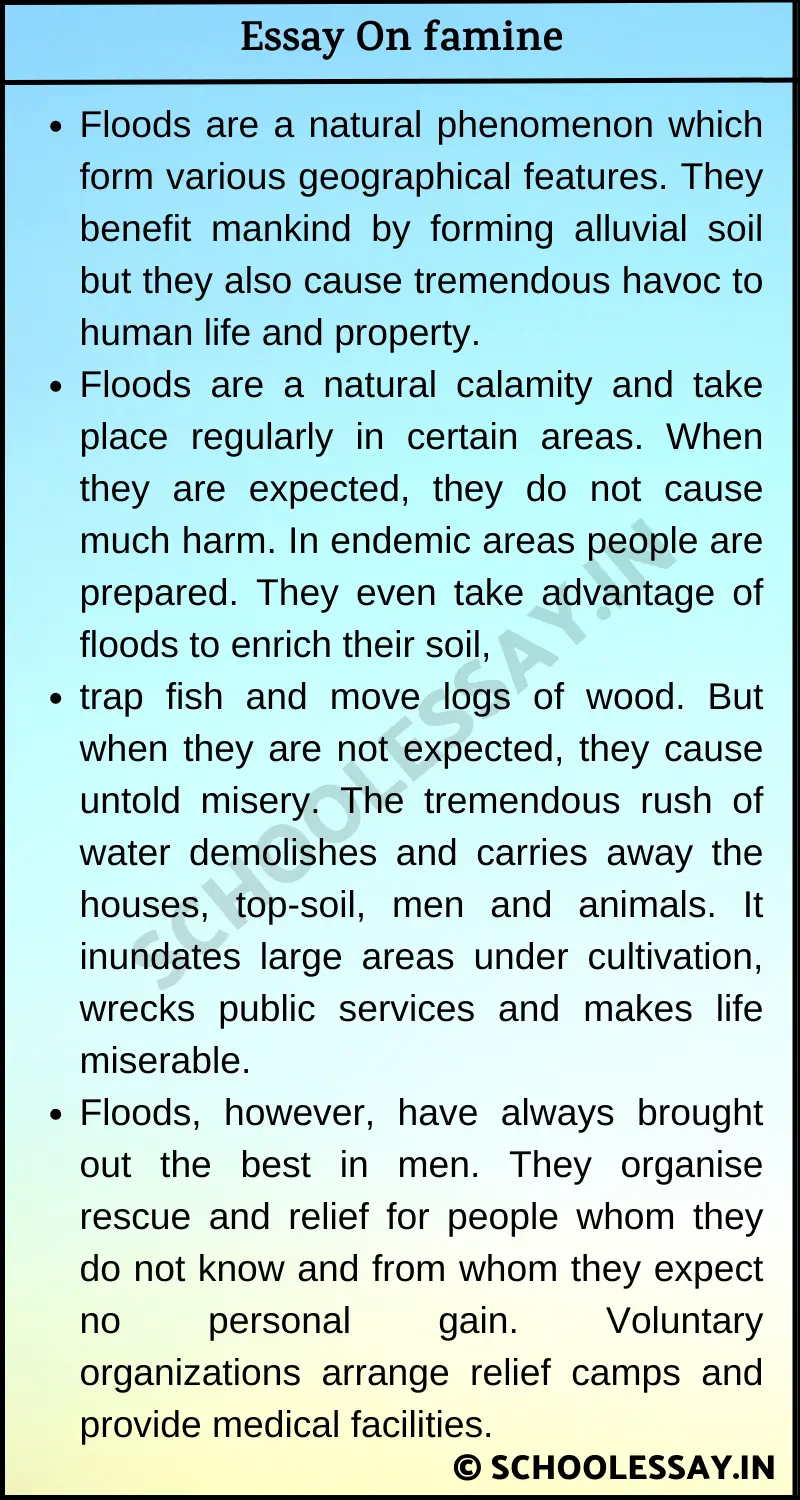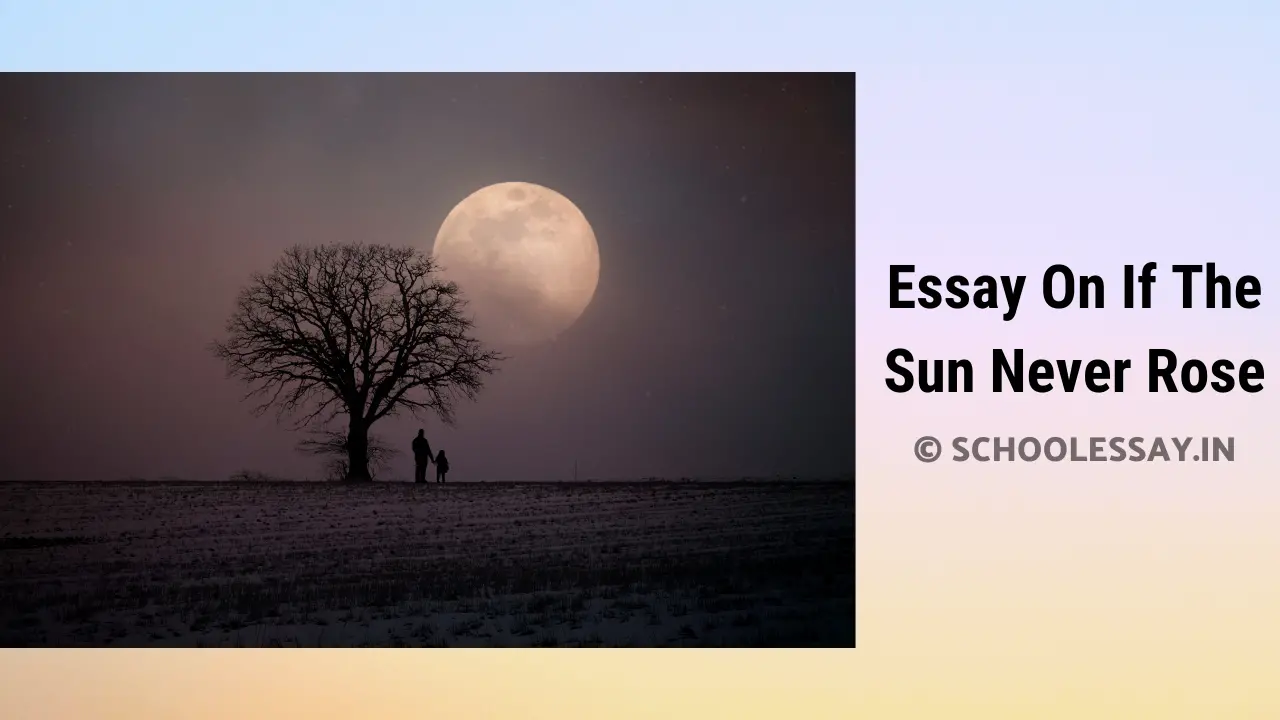Set 1: Essay On Natural Calamities Or Floods and Famines
Natural calamities such as floods, famines and earthquakes are a common feature of human life. They can cause massive destruction and great havoc anywhere and any time on this earth. Especially floods and famines affect our lives greatly.
In India, either we get too much of rain or we get no rain at all. When there are no rains, crops do not grow and when it rains torrentially, our crops are destroyed in the floods. In either case we suffer. As it is not possible to control the monsoons by any scientific methods, we have to depend on the rain god for our food production every year. Too much or too little rain causes famines. Every year there are floods in some parts of the country and famine in others.
Sometimes there is drought all over the country for want of rains and this leads to famine. Sometimes our crops are destroyed by heavy floods. There was a great drought in the country for many years in the seventies. It was followed by great floods in 1978 when crops were destroyed and several people lost their lives.
Whenever there are floods, the rivers cannot contain the enormous volume of water and the water flows into the adjoining areas causing heavy destruction of life and property. The old persons and children suffer untold miseries. Authorities have to press all emergencies into service to provide food by boats or by helicopters. When there are no rains, the earth becomes parched and there is famine. Many people have to starve because of drought.
When there is a famine, the government distributes grains, food and remits taxes on land and provides other help to the farmers. When there is flood, the government provides boats and helicopters to rescue people. It also provides alternate site for their residence. There is the Prime Minister’s Relief Fund and the Chief Minister’s Relief Fund to render help in any national calamity. Both floods and famines are, in fact, great national calamities.
Set 2: Essay On Natural Calamities
Natural calamities, such as floods, drought, forest fires, earth-quakes, volcanic eruptions, epidemics etc., sometimes take a heavy toll of plant and animal life. Floods are frequent in moist tropical regions of the world which inundate much of the ground vegetation, trap a large number of animals while leaching away soil nutrients to make the already poor tropical soil poorer.
Failure of monsoon, for example, in succession for two or three years dries up ground vegetation and as the subsurface water table recedes trees are also affected. With plant life animals also suffer. In such localities heavy seasonal downpour also causes extensive damages.
Forest fires in densely wooded localities often reduce to ashes a large number of plant and animal species and so do earth-quakes which, however, are not as frequent as floods or droughts. Volcanic eruptions may at times completely destroy plant and animal life in its surrounding areas. Such an eruption occurred in Columbia in November 1985.
The hot sulphur containing material coming out from the volcano melted ice on the mountain sides and formed thick black mud which swept down the slopes to cause enormous damage to plant, animal and human lives. The black mud now covers an area of 2800 sq-kms and has made the soil useless. No vegetation survives here. Fortunately such eruptions are not very frequent. It was 23rd eruption of the volcano since last four thousand years.
Epidemics sometimes destroy large portions of a natural population. Sporadic diseases are quit frequent in a natural community. However, at times virulent strains appear, cause diseases which put on the dimensions of an epidemic. A large number of organisms are killed. In nature such episodes are usually confined to specific plant or animal populations as the pathogen is often specific to particular species or group of species.
Set 3: Essay On famine
Famine is said to have struck when there arises a great scarcity of food. Famine arises when crops fail for some reason or the other. Sometimes crops may be destroyed by floods. Then there will be famine. At other times, there may be scarcity of rain. This will lead to a poor crop. So, there will not be enough grain to eat. In many parts of our country there is famine almost year round because of the drought conditions. The monsoon failure is a common cause. So the crops fail too.
It is heart-rending to see the miserable condition of the poor in the places where there is famine. Many die of extreme hunger. All become thin and weak. They have no strength to walk. The children cry pitifully because they are famished. Parents are helpless. There is not a morsel of food to give to their children.
People boil a few leaves and herbs in a pot with hot water and drink the mixture. It helps them to get rid of the empty feeling in their stomachs. Cattle too die in large numbers because they have neither fodder nor water.
There is not only a food shortage but also a water scarcity at most times. This is on account of the failure of the rains. The lakes have little water left and the wells in the villages become dry. One can do without food for some time, but who can live without water? The condition of men and animals becomes equally miserable.
To escape dying of hunger and thirst people from drought-hit areas make their way to the towns. There many of them beg, and manage to keep alive. Government has organized relief measures for all the drought-hit people. Government opens relief camps where victims of drought are given food and provided with employment. Volunteers organisations also arrange camps to supply readymade eatables.
Famine is a natural calamity that occurs from time to time. We should do our best to help those who have been affected by famine.

ALSO READ:
- Essay On Floods
- Essay On Scenes During a Strike
- Essay On Scenes on the Bank of a River
- Essay On The Traffic hazards in my city
- Essay On The Wonders of the e-mail
- Essay On The Television
- Essay On School Memories
- Essay On My Favourite Dream
- Essay On The Value of Discipline in School Life
- Essay On Value to Discipline


